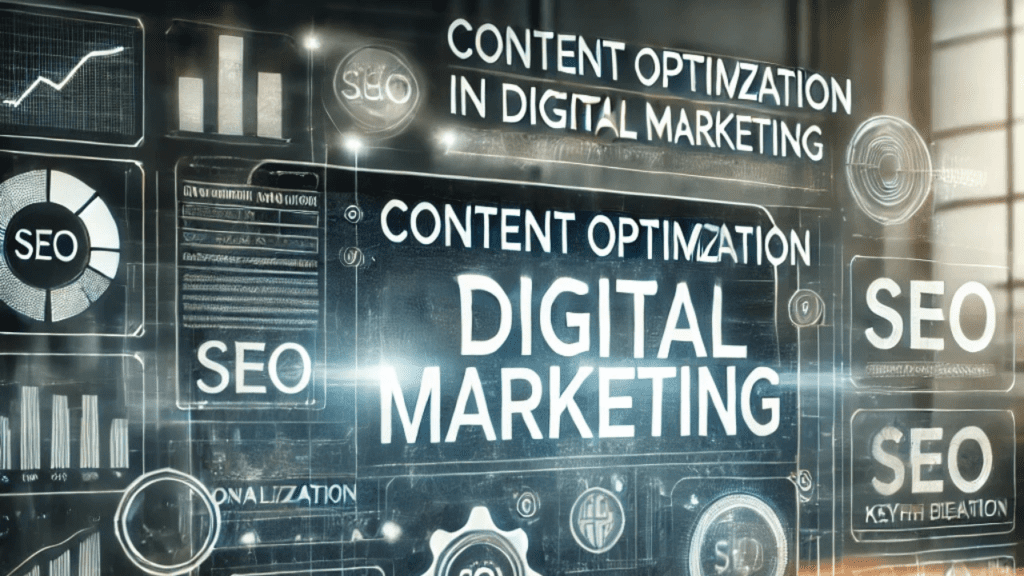
Introduction
Content Optimization in Digital Marketing is a crucial strategy that ensures your content ranks well on search engines and resonates with your target audience. With the ever-changing digital landscape, businesses must stay ahead by producing high-quality, optimized content that attracts potential leads and drives conversions. But what exactly does content optimization involve? And how can it help your digital marketing efforts generate more leads? Let’s dive deep into the world of content optimization and explore how it can be your ultimate game-changer in lead generation.
What is Content Optimization in Digital Marketing?
Content Optimization in Digital Marketing refers to the process of enhancing content so that it is more attractive, engaging, and useful for both search engines and users. It involves optimizing text, images, meta descriptions, keywords, and other elements to improve visibility, user engagement, and ultimately, lead generation.
The goal is to make content more relevant, authoritative, and persuasive so that it ranks higher in search results and drives organic traffic. When done effectively, content optimization increases the likelihood of conversions, helping businesses achieve their marketing goals.
Why Content Optimization is Essential for Lead Generation
1. Improves Search Engine Rankings
Search engines like Google prioritize well-optimized content. By incorporating relevant keywords, structuring content properly, and providing value, your content is more likely to rank higher in search engine results pages (SERPs), leading to increased visibility and traffic.
2. Enhances User Experience
User experience (UX) plays a significant role in digital marketing success. Optimized content is easy to read, informative, and visually appealing, ensuring that visitors stay longer on your website, explore more pages, and ultimately convert into leads.
3. Builds Brand Authority
High-quality, optimized content establishes your brand as an authority in your industry. When users find your content valuable, they are more likely to trust your brand, engage with your business, and become loyal customers.
4. Increases Conversion Rates
Optimized content not only attracts visitors but also guides them through the buyer’s journey. By using persuasive language, clear calls to action (CTAs), and engaging formats, you can significantly increase your conversion rates and generate more leads.
Key Elements of Content Optimization in Digital Marketing
1. Keyword Research and Implementation
Effective keyword research is the foundation of content optimization. Use tools like Google Keyword Planner, Ahrefs, or SEMrush to find high-ranking keywords relevant to your industry. Incorporate these keywords naturally within your content to improve SEO performance.
2. High-Quality and Engaging Content
Content should be informative, valuable, and engaging. Ensure that it addresses users’ pain points, provides solutions, and encourages interaction. Use storytelling techniques, data-driven insights, and case studies to make your content compelling.
3. On-Page SEO Optimization
On-page SEO factors play a crucial role in content optimization. Here are some essential elements to focus on:
- Title Tags: Include the primary keyword in the title.
- Meta Descriptions: Write compelling meta descriptions with target keywords.
- Headings and Subheadings: Use structured headings (H1, H2, H3) with relevant keywords.
- Internal and External Links: Link to authoritative sources and relevant internal pages.
- Image Optimization: Use alt text and compressed images for faster loading speeds.
4. Readability and Formatting
Ensure that your content is easy to read by using short paragraphs, bullet points, and subheadings. Use a conversational tone, avoid jargon, and make your content accessible to a broad audience.
5. Mobile Optimization
With the increasing use of mobile devices, content should be mobile-friendly. Ensure fast loading times, responsive design, and easy navigation to enhance user experience on all devices.
6. Visual and Multimedia Elements
Incorporate images, videos, infographics, and other multimedia elements to make your content more engaging. Visual content can increase retention rates and boost social media shares, driving more traffic to your website.
7. Call-to-Actions (CTAs)
Strong CTAs are essential for converting visitors into leads. Use action-oriented language, compelling offers, and strategic placement to encourage users to take the desired action.
Advanced Content Optimization Strategies
1. Content Personalization
Personalized content enhances user engagement and conversion rates. Use data analytics and AI-driven tools to tailor content based on user preferences, demographics, and behavior.
2. Voice Search Optimization
With the rise of voice search, optimizing content for conversational queries is crucial. Use long-tail keywords and natural language to improve visibility in voice search results.
3. Content Repurposing
Repurpose existing content into different formats such as podcasts, videos, and infographics. This maximizes reach and engages different audience segments across multiple platforms.
4. A/B Testing
Experiment with different headlines, CTAs, and content structures to determine what works best. A/B testing helps refine content for better engagement and conversion rates.
5. User-Generated Content
Encourage users to create and share content related to your brand. Testimonials, reviews, and social media mentions build credibility and foster community engagement.
Measuring the Success of Content Optimization
Tracking performance metrics is essential to determine the effectiveness of your content optimization strategy. Key performance indicators (KPIs) include:
- Organic Traffic: Measure the number of visitors coming from search engines.
- Bounce Rate: Analyze how long users stay on your page.
- Conversion Rate: Track the percentage of visitors converting into leads.
- Engagement Metrics: Assess shares, comments, and time spent on content.
- Keyword Rankings: Monitor keyword positions to ensure continuous improvement.
Conclusion
Content Optimization in Digital Marketing is a powerful tool for attracting leads, improving search rankings, and enhancing user experience. By implementing keyword research, on-page SEO, mobile optimization, and advanced strategies like personalization and voice search optimization, businesses can maximize their content’s impact and drive more conversions.
A well-optimized content strategy doesn’t just help you rank higher on search engines; it also establishes your brand as a trusted authority, ensuring long-term success in the digital marketing landscape. Start optimizing your content today, and watch your leads grow exponentially!
